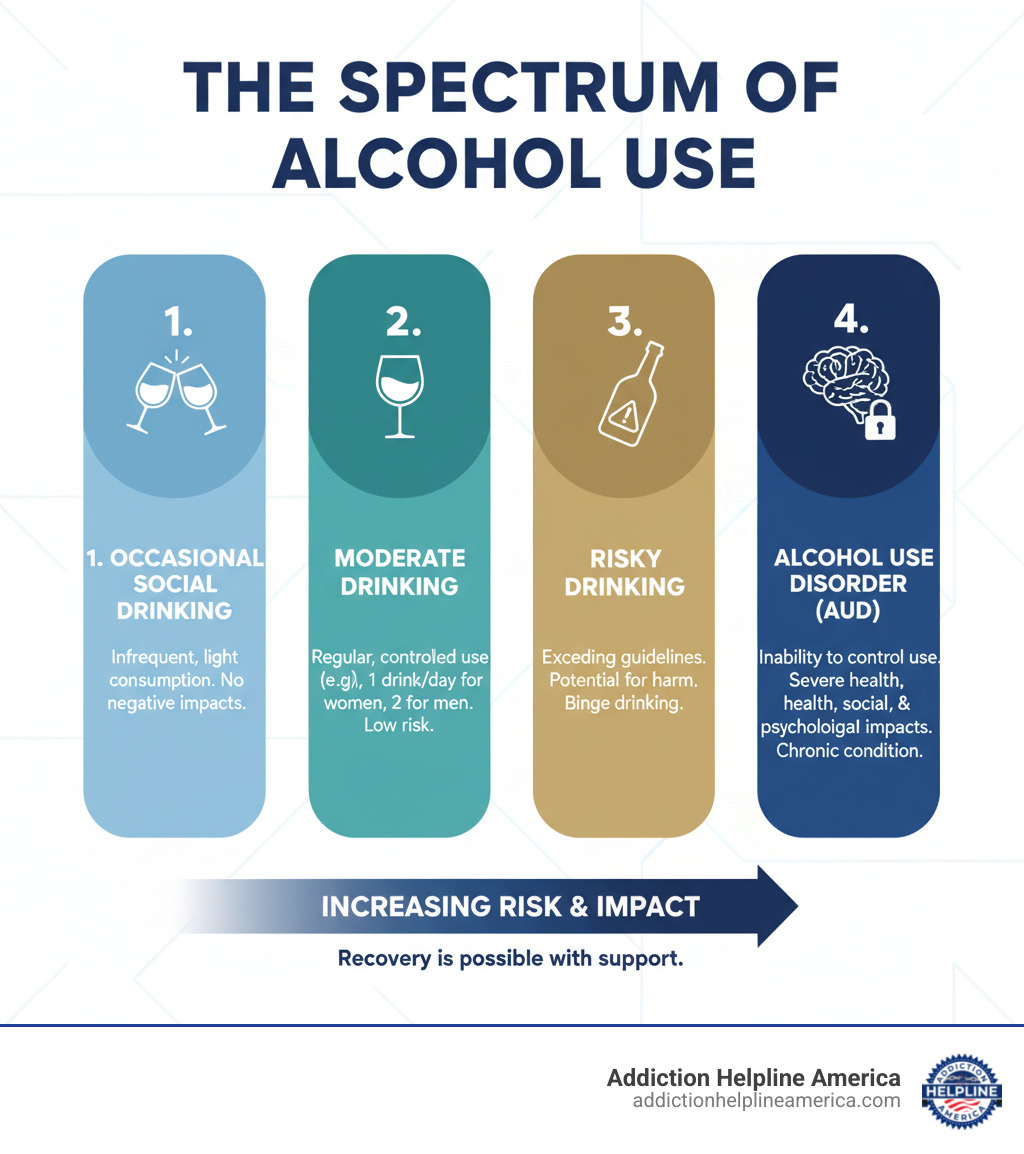
Understanding Alcohol Use Disorder: A Serious But Treatable Condition
While alcoholic is a common term, the medical community uses “alcohol use disorder” (AUD) to describe this chronic brain disease. AUD is a medical condition where a person cannot stop or control their alcohol use despite serious consequences. It is not a moral failing but a treatable brain disorder that exists on a spectrum from mild to severe.
Globally, about 283 million people have AUD. The disorder is often misunderstood as a choice, but it’s a medical condition that changes brain function, making it extremely difficult to control drinking. The impact is staggering: alcohol contributes to 3.3 million deaths annually and is a leading cause of early death in the U.S., reducing life expectancy by about ten years.
However, there is hope. Most people with AUD can reduce their drinking or stop entirely with proper treatment. Understanding AUD is the first step toward recovery.
At Addiction Helpline America, we support individuals and families affected by AUD. We provide confidential guidance and connect people with effective, personalized treatment. Seeking help for alcoholic behavior takes courage, and our team of specialists is here to support you.

What is Alcohol Use Disorder (AUD)?
Alcohol use disorder (AUD) is a medical condition defined by the inability to stop or control drinking despite negative consequences. AUD is not a moral failing or a sign of weakness; it’s a chronic brain disorder that alters brain function, making it incredibly difficult to manage alcohol use without help. The medical community has moved away from the stigmatizing term alcoholic, preferring “alcohol use disorder” to reflect that it is a treatable condition.
The Diagnostic and Statistical Manual of Mental Disorders, Fifth Edition (DSM-5), outlines the diagnostic criteria. A key concept is that AUD exists on a spectrum from mild to moderate to severe, based on the number of symptoms present.
A person meets the criteria for AUD if they experience two or more of the following 11 symptoms within a 12-month period:
- Drinking more or longer than intended.
- Wanting to cut down but being unable to.
- Spending a lot of time obtaining, using, or recovering from alcohol.
- Experiencing strong cravings or urges to drink.
- Failing to fulfill major responsibilities at work, school, or home due to drinking.
- Continuing to drink despite social or interpersonal problems.
- Giving up important activities because of alcohol use.
- Drinking in physically hazardous situations (e.g., driving).
- Continuing to drink despite knowing it’s causing or worsening a physical or mental health problem.
- Developing tolerance: needing more alcohol to get the same effect.
- Experiencing withdrawal symptoms when not drinking, or drinking to avoid them.
The severity is classified as mild (2-3 symptoms), moderate (4-5 symptoms), or severe (6 or more symptoms). This spectrum approach allows for more precise diagnosis and custom treatment, a framework supported by scientific research on AUD diagnosis.
The Shift from “Alcohol Abuse” and “Dependence”
Previously, the DSM-IV used two separate categories: “alcohol abuse” (problematic drinking with negative consequences) and “alcohol dependence” (a more severe form with tolerance and withdrawal). This system created an artificial divide and carried significant stigma, often preventing people from seeking help early.
The DSM-5 combined these into the single diagnosis of alcohol use disorder. This change reflects the understanding that problematic drinking exists on a continuum. By recognizing AUD as a spectrum, the medical community encourages earlier intervention and more personalized, compassionate care, reducing the shame associated with labels like alcoholic or “dependent.”
How is AUD Diagnosed?
Diagnosing AUD requires a thorough and honest assessment by a healthcare professional, such as a doctor, psychiatrist, or addiction specialist.
The process typically includes:
- A detailed conversation about your drinking patterns and their consequences.
- Screening questionnaires like the AUDIT (Alcohol Use Disorders Identification Test) or CAGE to identify problematic drinking.
- A physical exam to check for signs of alcohol-related health issues, like liver enlargement or neurological changes.
- Lab tests to look for biomarkers of heavy drinking or organ damage. While no single test diagnoses AUD, markers like GGT, PEth, and CDT can provide important evidence.
- A psychiatric evaluation to identify co-occurring mental health conditions like depression or anxiety, which are common with AUD and often require simultaneous treatment.
At Addiction Helpline America, we can confidentially guide you toward professionals who can conduct a thorough assessment and recommend the right treatment for your situation.
Recognizing the Signs: Symptoms and Effects of an Alcoholic
When someone struggles with alcohol use disorder, the signs appear gradually, affecting their health, relationships, and daily life. Recognizing these warning signs is the first step toward getting help.

Short-Term and Long-Term Symptoms
Alcohol’s effects can be immediate or develop over time.
Short-term effects during or after drinking include impaired judgment, poor coordination, slurred speech, and mood swings. These can lead to accidents, injuries, and blackouts—periods of memory loss. In severe cases, heavy drinking can cause alcohol poisoning, a life-threatening emergency.
Long-term symptoms develop with chronic use. Key signs include:
- Tolerance: Needing more alcohol to feel the same effect.
- Withdrawal: Experiencing physical and psychological discomfort (tremors, anxiety, nausea) when not drinking.
- Cravings: Intense urges to drink.
- Loss of Control: Repeatedly failing in attempts to quit or cut back.
- Behavioral Changes: Hiding drinking, lying about consumption, neglecting responsibilities, and losing interest in hobbies.
- Relationship Problems: Frequent conflicts with family and friends.
What Are the Long-Term Health Effects for an Alcoholic?
Chronic heavy drinking damages nearly every organ in the body. The World Health Organization states that no level of alcohol is completely safe for health.
- Liver Damage: Alcohol can cause a progression of liver disease, from fatty liver to alcoholic hepatitis and irreversible cirrhosis, significantly increasing the risk of liver cancer.
- Digestive System: It can lead to pancreatitis (inflammation of the pancreas), gastritis, ulcers, and an increased risk of pancreatic cancer.
- Cardiovascular System: Chronic use can cause high blood pressure, alcoholic cardiomyopathy (weakened heart muscle), and irregular heartbeats.
- Cancer Risk: Alcohol is a known carcinogen. Detailed information on alcohol and cancer risk links it to cancers of the mouth, throat, esophagus, liver, colon, and breast.
- Neurological Damage: Alcohol is a neurotoxin that can cause brain injury. It is the second leading cause of dementia and can lead to peripheral neuropathy (nerve damage) and Wernicke-Korsakoff syndrome, a severe memory disorder.
- Weakened Immune System: Alcohol impairs the body’s ability to fight off infections like pneumonia and tuberculosis.
Mental and Psychiatric Complications
Alcohol and mental health are deeply intertwined. Co-occurring disorders are extremely common, with many people with AUD also suffering from depression, anxiety, PTSD, or other psychiatric conditions. People often use alcohol to self-medicate, but this backfires, as alcohol typically worsens these conditions over time.
The increased risk of suicide is one of the most tragic consequences of untreated alcoholic behavior. Alcohol impairs judgment, increases impulsivity, and deepens depression, a dangerous combination that significantly lifts suicide risk. For those with existing mental health issues, alcohol can interfere with medications and make symptoms harder to manage.
Recognizing these signs is frightening but powerful. If they feel familiar, know that help is available. Our team at Addiction Helpline America can provide confidential guidance and connect you to treatment that addresses both AUD and any co-occurring mental health concerns.
What Causes Alcohol Use Disorder?
No single factor causes alcohol use disorder. Instead, it develops from a complex interplay of genetic, environmental, and psychological influences. Understanding these contributing factors is key to understanding the condition.

Genetic and Biological Factors
Genetics play a significant role, accounting for about 50-60% of the risk for AUD. Having a parent or sibling with AUD increases your risk by 3-4 times. Certain genes influence how the body metabolizes alcohol, which can either increase or decrease the risk of becoming alcoholic. Chronic alcohol use also changes brain chemistry, particularly the dopamine (reward) and GABA (calming) systems. These changes can create powerful cravings and a compulsion to drink that is difficult to resist.
Environmental and Social Factors
Your environment and life experiences are just as important as biology. Key factors include:
- Peer pressure and social norms: Heavy drinking being normalized in one’s social circle or culture increases risk.
- High-stress environments: Many people turn to alcohol to cope with stress from work, finances, or relationships.
- Trauma: A history of trauma, especially in childhood, is a major risk factor, as alcohol can be used to numb emotional pain.
- Early age of first drink: Starting to drink during adolescence can alter brain development and create a long-term vulnerability to AUD.
- Availability: Alcohol’s easy access and low cost contribute to increased consumption and risk.
Psychological Factors
Your internal emotional state also plays a crucial role. People with mental health conditions like depression, anxiety, or PTSD often use alcohol to self-medicate, creating a vicious cycle where alcohol worsens the underlying condition. Low self-esteem and personality traits like impulsivity can also increase the risk of developing problematic drinking patterns.
At Addiction Helpline America, we know these factors overlap in complex ways. This is why personalized treatment is so effective. Reaching out is the first step to understanding your unique situation and finding the right path forward.
The Path to Recovery: Diagnosis and Treatment for AUD
If you’re exploring recovery, know this: recovery from alcohol use disorder is not just possible—it happens every day. The journey begins with the courageous step of acknowledging the problem and seeking help. You don’t have to do it alone; professional support makes the path safer and more effective.

Managing Alcohol Withdrawal
Stopping or cutting back on heavy, prolonged drinking can trigger Alcohol Withdrawal Syndrome (AWS), which can be dangerous. Symptoms like tremors, anxiety, and nausea typically begin within hours and peak in 1-3 days. In severe cases, a medical emergency called Delirium Tremens (DTs) can occur, involving confusion, hallucinations, and seizures.
Because of these risks, attempting to detox “cold turkey” is not recommended. Managing alcohol withdrawal safely requires medical supervision. In a detox facility, professionals monitor you and use medications (primarily benzodiazepines) to manage symptoms and prevent complications. For a better understanding of this phase, see our Alcohol Withdrawal Timeline.
What Are the Treatment Options for an Alcoholic?
After detox, the work of recovery begins with a variety of effective treatment options. Personalized care is key, as what works for one person may not work for another.
- Behavioral Therapies: These are the foundation of treatment. Cognitive Behavioral Therapy (CBT) helps change negative thought patterns that lead to drinking, while Motivational Improvement Therapy (MET) builds internal motivation to change. Group therapy provides peer support and shared experience.
- Medications: Several FDA-approved medications can help. Naltrexone reduces cravings, Acamprosate helps restore brain chemistry, and Disulfiram causes unpleasant effects if alcohol is consumed, acting as a deterrent.
- Treatment Settings: Inpatient or residential programs offer 24/7 structured care away from daily triggers, ideal for severe AUD or co-occurring conditions. Our network includes high-quality options like Luxury Alcohol Rehab Malibu. Outpatient programs allow you to live at home while attending regular therapy sessions. Learn more about Outpatient Treatment or find Drug Detox and Rehab Facilities Near Me.
- Holistic Therapies: Practices like yoga, meditation, and art therapy can complement traditional treatment by reducing stress and promoting overall well-being.
The Role of Support Groups
Peer support groups are strongly linked to better long-term outcomes. Connecting with others who understand the journey is incredibly powerful.
- Alcoholics Anonymous (AA): The most well-known 12-Step fellowship. Research on the effectiveness of AA shows that participation improves abstinence rates.
- Alternatives to AA: Other excellent options exist. SMART Recovery is a science-based program focused on self-empowerment. Women for Sobriety is designed for women, while LifeRing Secular Recovery offers a non-religious approach.
These groups provide crucial ongoing support, especially during aftercare. Learn more about this phase in our guides on What is Rehab Aftercare? and Post Rehab Drug Rehab Aftercare. Recovery is a process, but with the right combination of treatment and support, a life free from alcohol is achievable.
Frequently Asked Questions about Alcohol Use Disorder
What are the guidelines for moderate drinking?
The U.S. Dietary Guidelines define moderation as 2 drinks or less per day for men and 1 drink or less per day for women. These are upper limits, not targets. The World Health Organization (WHO) states that no level of alcohol is entirely safe. Exceeding these limits increases health risks, including cancer, liver disease, and heart problems. Binge drinking (4+ drinks for women, 5+ for men in about 2 hours) is especially hazardous. No amount of alcohol is safe during pregnancy.
How does alcohol affect women differently than men?
Women are affected more severely by alcohol due to biological differences:
- Higher BAC: Women typically have less body water, resulting in a higher blood alcohol concentration (BAC) than men after drinking the same amount.
- Faster Organ Damage: Women tend to develop alcohol-related health problems like cirrhosis and heart disease more quickly and after consuming less alcohol.
- Telescoping Effect: Women often progress more rapidly from initial use to developing AUD.
- Increased Cancer Risk: Even moderate drinking increases a woman’s risk for breast cancer.
- Co-occurring Disorders: Women with AUD are more likely to also have depression, anxiety, or PTSD.
What is the prognosis for someone with AUD?
The prognosis for AUD is hopeful. While it is a chronic disease, it is treatable, and recovery is possible.
- Recovery is Achievable: With treatment, most people can reduce their drinking or stop completely.
- Relapse is Not Failure: Relapse can be part of the recovery process. It’s a sign to adjust treatment, not that it has failed.
- Treatment Improves Outcomes: Engaging in therapy, medication, and support groups significantly improves quality of life and long-term sobriety.
- Early Intervention Helps: It is not necessary to “hit rock bottom.” Seeking help early can prevent the most severe consequences of AUD.
Conclusion: Finding Hope and Help for Alcoholism
This guide has shown that alcohol use disorder is a treatable medical condition, not a character flaw. The most important message is that recovery is absolutely possible.
Recognizing a problem with alcohol takes courage. The stigma around the word alcoholic can make it hard to seek help, but millions have walked this path and found healthier, fuller lives. Recovery is about progress, not perfection, and it starts with the first step of reaching out.
At Addiction Helpline America, we make that step easier. Our team offers free, confidential guidance to connect you with the right resources, from detox and inpatient treatment to therapy and support groups. Your situation is unique, and we are committed to helping you find a personalized path to recovery.
You don’t have to do this alone. Help is available now.
Find personalized addiction treatment options
Recovery begins with hope—and hope begins with reaching out. We’re here when you’re ready.
Our helpline is 100%
free & confidential
If you or someone you care about is struggling with drug or alcohol addiction, we can help you explore your recovery options. Don’t face this challenge alone—seek support from us.
Programs
Resources
Will my insurance
cover addiction
treatment?
We're ready to help
Find the best
drug or alcohol treatment
center
Are you or a loved one struggling with addiction? Call today to speak to a treatment expert.












